Day 2 of a two day weekend of Bird Tours in North Norfolk. Having been west along the coast yesterday, we headed out east for the day today. It had been forecast to be cloudier than yesterday, but we were not expecting to have the fog which clung on along the coast all day. It meant that migration along the coast was limited today, but we still managed to find a few migrants despite the weather.
Our first destination was Cley. It had looked to be brightening up as we drove along the coast road, but by the time we got to the East Bank, we could see the fog rolling in out towards the coast. A Kestrel was hovering over the edge of the reedbed. It gradually worked its way closer and then, as we watched it, it dropped steeply down into the grass just beyond the car park. When it came up again it had a vole in its talons. A Grey Heron dropped out of the trees and down towards the pools.

Up on the bank, we could see several Common Pochard on Don’s Pool, along with a single drake Tufted Duck. They were all diving constantly. Over the other side of the bank, we could see lots of Greylag Geese out on the grazing marshes. There were still a few Wigeon out here too, plus several Teal, a couple of Shoveler and a pair of Gadwall.
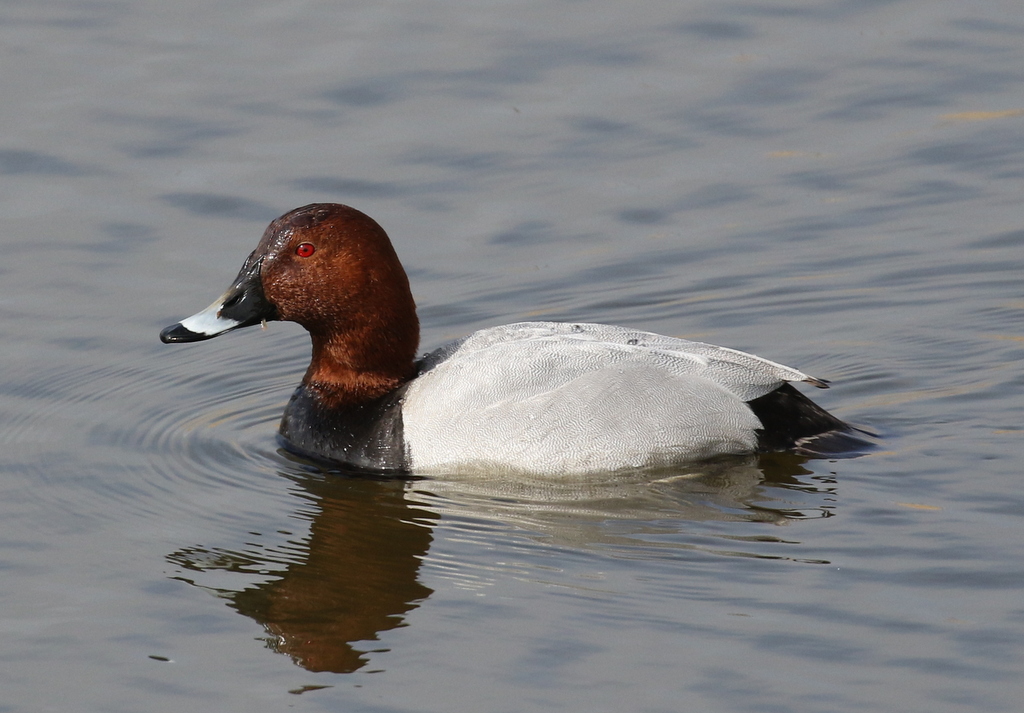
The Redshanks were displaying here today – they were very vocal and we saw several in display flight, fluttering their bowed wings as they called. The Lapwings were a bit more subdued in the weather, though we did see one or two tumbling. There were plenty of Avocets but they were right at the back, on Pope’s Pool, in the fog. We could hear them calling noisily. We stopped to look at a Ruff feeding on the edge of the Serpentine.
A Bearded Tit pinged from the reedbed, but remained stubbornly down out of view today. A Marsh Harrier circled out over Pope’s reedbed, in the fog, and then another appeared much closer, over the reeds the other side.
We made our way on Arnold’s Marsh and took advantage of the shelter. There was a good selection of waders out on here today. There were several Bar-tailed Godwits, some still in non-breeding plumage, but several starting to moult and one particularly smart individual already in summer plumage, deep rusty coloured below, right down to under the tail.
There was a good number of Dunlin on the mud at the back, accompanied by a couple of Ringed Plovers. A single Grey Plover on one of the shingle spits was still in grey non-breeding plumage. There were plenty of Avocets and Redshanks on here too.
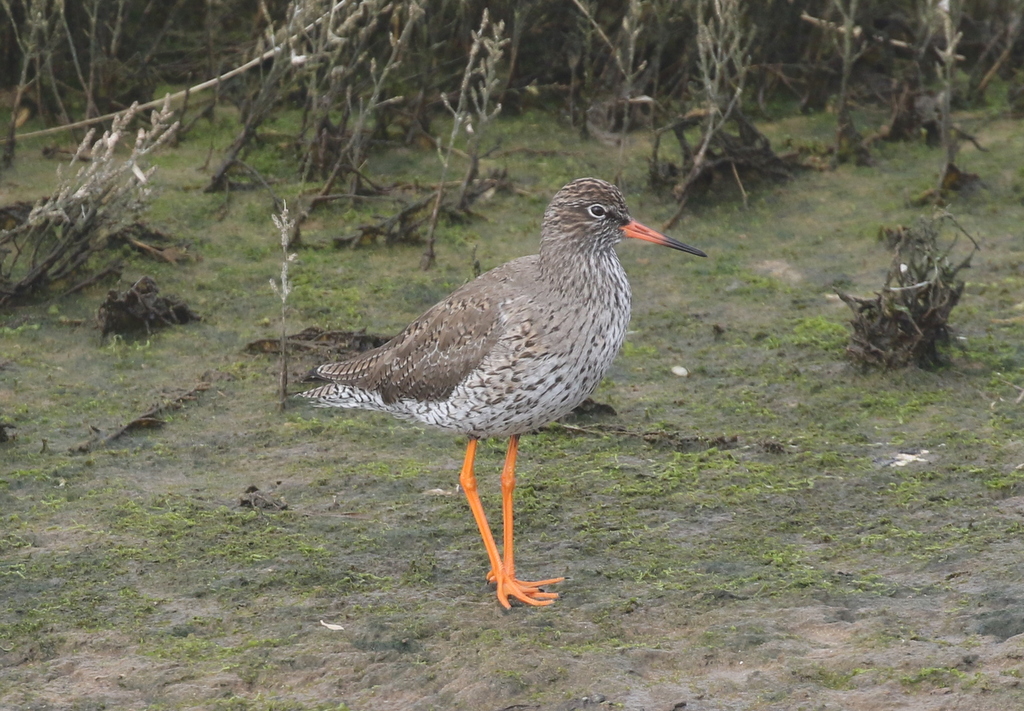
We managed to pick out two Sandwich Terns on the small shingle island at the back, and we could see their shaggy crests even if they were mostly sleeping. Then more Sandwich Terns flew in and landed with them and there was lots of calling and displaying, so we could see their yellow-tipped black bills. We went to have a look out at the sea, but it was too foggy now to even see the waves, so we headed back.
It was brighter back at the car, but we drove back into the fog along Beach Road. The edge of the Eye Field is a good place to look for Wheatears and thankfully we found a couple close to the edge, where we could see them. They were feeding down in the grass just beyond the fence, but one came out onto the shingle and perched on a couple of the fence posts.
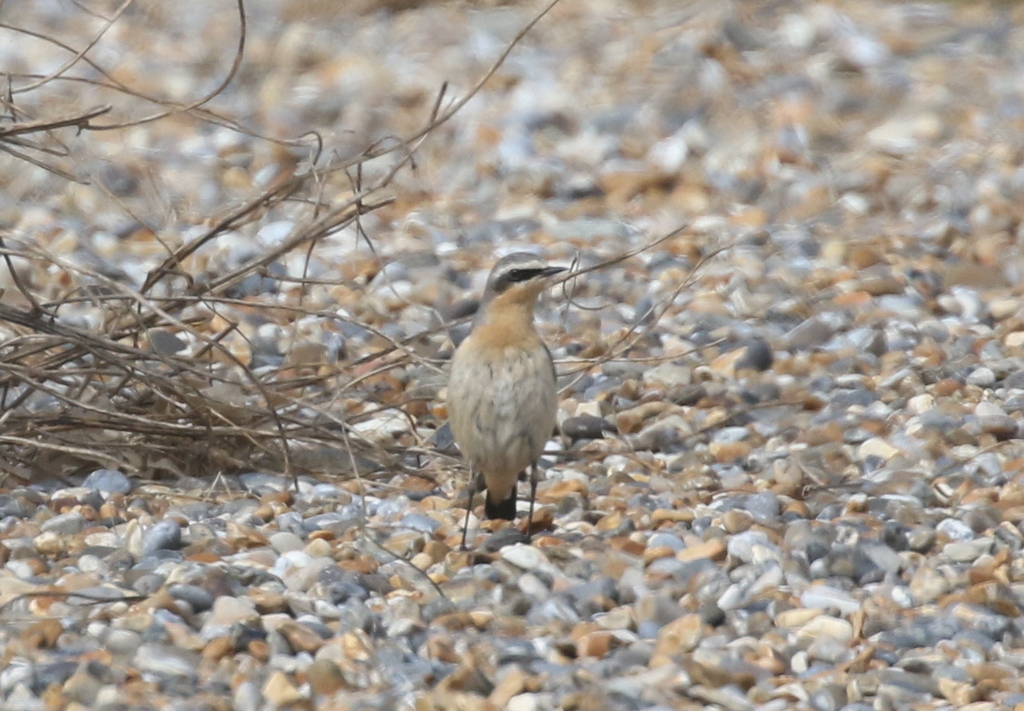
Both the Wheatears were males and both looked to be large and richly coloured below, with a comparatively deep burnt orange wash across the breast. They looked to be Greenland Wheatears, stopping off on their way before making the long journey most of the way across the Atlantic
With our mission here accomplished, we decided not to linger in the fog and drove back east along the coast road. A quick stop at Salthouse duckpond and scan of the pools beyond didn’t produce anything new, but we did stop to admire a pair of Gadwall. The drakes in particular are very intricately patterned, belying there ‘grey and boring’ image. There was also a Canada Goose on the pond and more Wigeon and Teal on the wet grazing marshes beyond.

The pools along Salthouse Beach Road can be good for migrants, but there was nothing here today. It was very foggy now along the shingle ridge and with few migrants apparently moving along the coast today, we decided it probably wasn’t going to be worth walking out to Gramborough Hill.
Continuing on to Kelling, we drove back into the sunshine as we headed slightly inland. As we parked in village the, a Common Buzzard was soaring high overhead, above the thing hazy cloud. A Swallow appeared overhead, hawking or insects, and disappeared off towards the road. When we got over there, we found a pair of Swallows on the wires. Rather than being on their way through, these birds had probably returned here to breed.
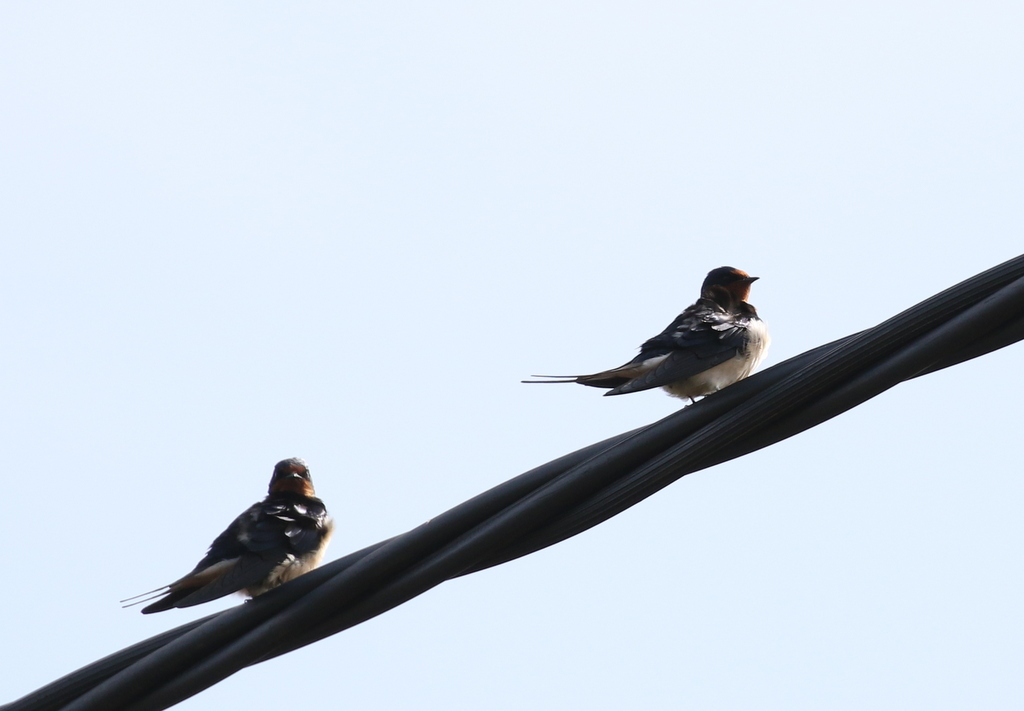
A pair of Pied Wagtails and a couple of Goldfinches were feeding on the playing field and a Chiffchaff was singing in the grounds of the school opposite. As we walked along the lane, a male Blackcap flew across in front of us and landed briefly in the bushes. Up at the copse, another Blackcap was singing in the trees and a pair of Chiffchaffs were fliting around, the male stopping to sing from time to time as it followed what was presumably a female.
It was increasingly foggy again as we got closer to the coast. Down at the Water Meadow, there were good numbers of Avocet feeding out in the water and calling noisily, plus a single lone Redshank and a few Teal. As we walked along the cross track on the north side of the water meadow, we heard a Whimbrel call. We looked across the Quags and saw it emerge from the fog and fly past us. It didn’t stop and headed off SE. Another good spring migrant.
We walked down towards the beach but it was very foggy down by the sea now. We had a quick scan of the Quags pools, but couldn’t see anything of note in the mist, so wee decided to head back to the Visitor Centre at Cley for lunch.
The weather was not too bad at Cley, so we ate our lunch outside, on the picnic tables. One or two Pied Wagtails kept flying back and forth overhead, commuting to the field behind. Just as we finished our lunch, we heard a Yellow Wagtail call and looked up to see it flying east in front of us. It turned back just before North Foreland Wood, and came back around over behind the Visitor Centre. It dropped down and looked like it might be landing in the field behind. We walked up to the back of the Visitor Centre to look for it, but there was no sign of it in the field, just one of the Pied Wagtails.
After lunch we paid a quick visit to the Iron Road. As we got out of the car, we could see three Egyptian Geese asleep in the grass with the Greylags. Two Brent Geese flew in to join them, Dark-bellied birds yet to set off back to Russia to breed. A Little Egret was feeding on one of the wet flashes in the grass.
It was a bit clearer now, so we walked up along the track to the pool. There were several Ruff around the muddy margins, and we stopped to look at a small group. Of the six birds, one was much smaller, a female ‘Reeve’. Most of the Ruff were rather pale, but one male was very dark, blackish speckled. They are the most variable of waders and they are now starting to moult into breeding plumage, although the males will not get their elaborate ruffs for a while yet. There were a couple of Redshanks on the pool too, for comparison.
There had been a White Wagtail here this morning and we found it again feeding on one of the grassy island. White Wagtail is the continental cousin of our Pied Wagtail and just passes through here on migration in the spring. This one had stopped off to feed. We could see its silvery grey back, much paler than the black or slate grey backs of our Pied Wagtails. A Swallow flew over, heading west, the first hirundine we had seen on the move today, they were obviously held up further south by the weather.

There seemed to be more fret rolling in from the east, so we decided to head inland, up to the Heath to try to find some brighter weather. It was nice and bright, sunny with some high hazy cloud, when we arrived in the car park. We could hear Chiffchaffs and a Willow Warbler singing in the trees.
We headed first for a sheltered corner which always catches the afternoon sun. We could hear Bullfinches calling, flew and a pair flew across in front of us and disappeared into trees. We were looking at the margins of the gorse to see if we could find any Adders, when a small bird flew up ahead of us calling a distinctive ‘speez, speez’. It was a Tree Pipit. They used to breed up here on the Heath, but have died out in recent years, so this was most likely a migrant, stopping just off on its way further north.
We walked round the corner to see if we could find the Tree Pipit on the ground, but it was obviously hiding in the trees. It then flew out and landed in the birches behind us briefly, then flew again and disappeared. It seemed to be trying to come back down into the grass to feed, so we left it in peace. You can find migrants inland, not just on the coast!
Scanning the leaf litter on the bank which faces the sun, we spotted our first Adder. Unfortunately, it headed straight into cover but the second Adder we found was more obliging, and stayed curled up in the grass for a few seconds before it decided our combined presence was too much and it disappeared into a hole in the vegetation.
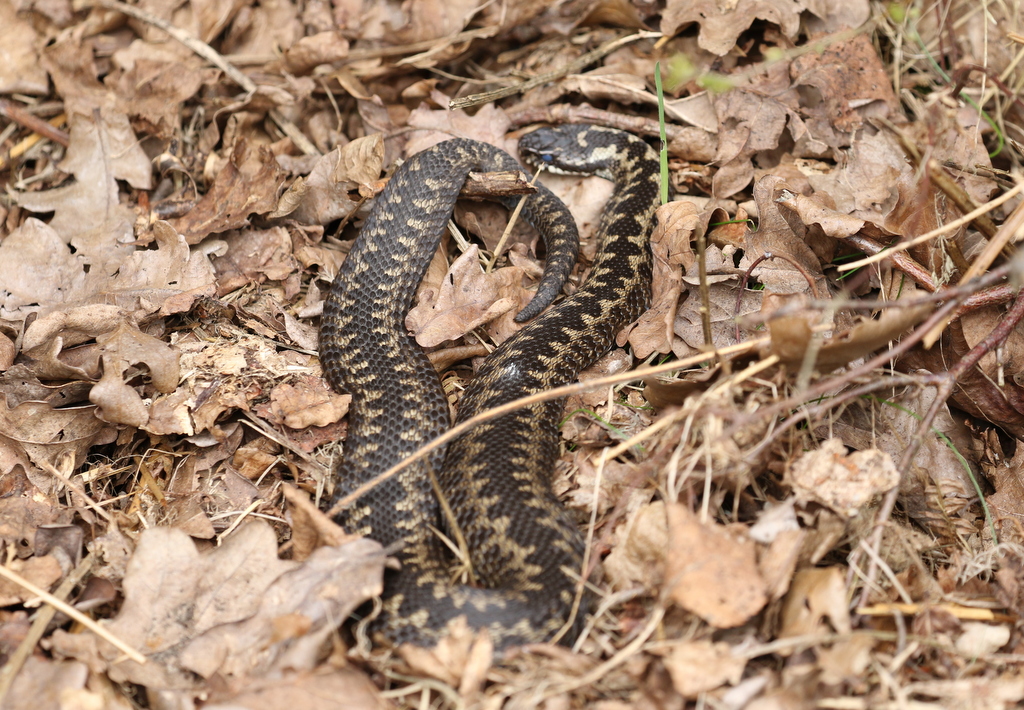
While we were watching the Adder, one of the group spotted a Common Lizard basking nearby. Then a young Common Frog hopped out of the leaves too. It was all action in this corner of the Heath this afternoon!
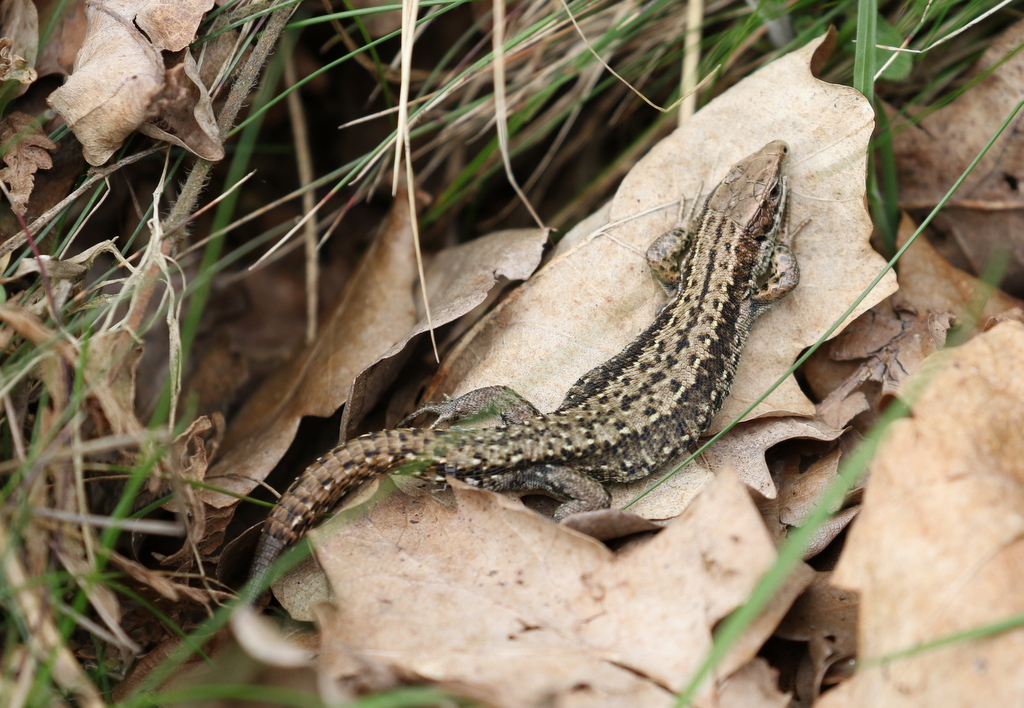
Walking back up the track, we stopped to look at a Willow Warbler in the top of a small birch tree, as a Red Kite drifted overhead. We heard a Woodlark calling and turned to see it flying towards us. It circled round over a more open area of grass, singing – a beautiful if slightly melancholic song. Then it appeared to drop down beyond the trees behind us. We walked back and found two Woodlarks on the ground.
The male Woodlark didn’t stay long, but took off again and started to fly round singing, while the female fed quietly in the grass. It was remarkably hard to see against the browns of the dead bracken, until it moved. We had a great look at it through the scope, before it too took off and headed away in the direction the male Woodlark had flown.
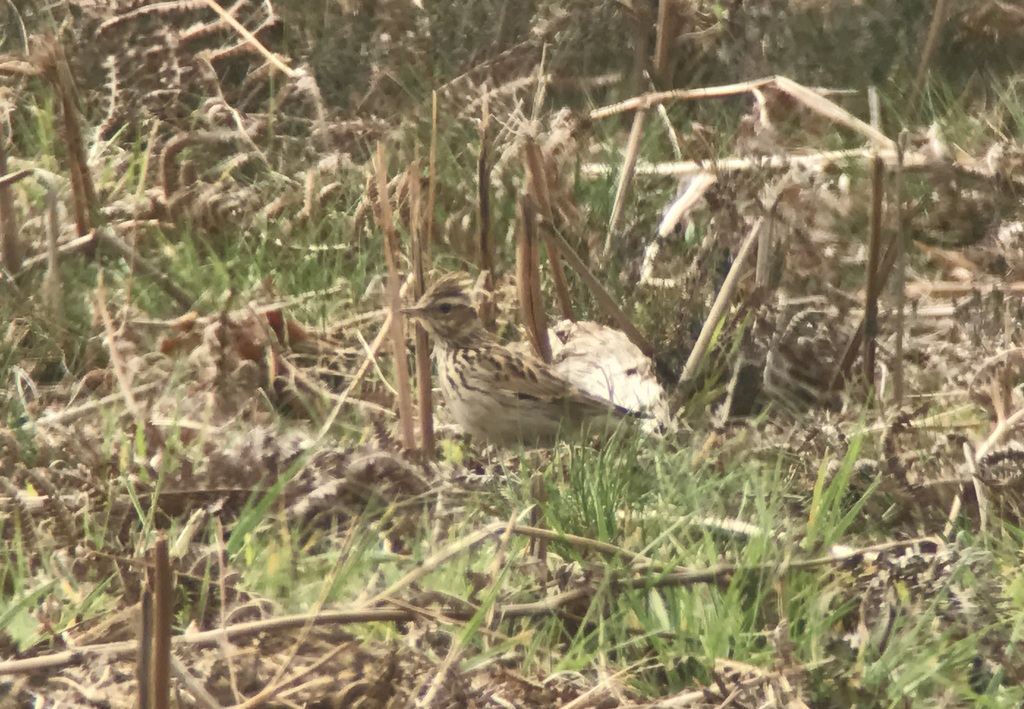
As we walked across the Heath and entered one of the traditional Dartford Warbler territories, we could hear one calling ahead of us. Unfortunately, by the time we got there it had gone quiet and despite walking round the area for a couple of minutes we didn’t hear it again. Still it was a good start.
We made our way further on, to another territory, and stopped to listen again. Once more, it was all quiet, despite the warmth from the sun, perhaps because it was now late in the afternoon. As we turned to leave, we saw something flit across in a dense clump of gorse right next to us. As we stood and watched a Dartford Warbler stuck its head out.

The Dartford Warbler appeared to be feeding on the bright yellow gorse flowers, presumably looking for insects. It was on the move constantly and very hard to see, only occasionally appearing on top of the bush. We followed it for a while as it fed quietly before it eventually dropped down out of view as the sun disappeared behind some clouds.
Another Woodlark flew over calling, and a few seconds later presumably the same bird came back the other way singing, right over our heads. There were plenty of Linnets around the Heath and we could hear several Yellowhammers calling, but the one resident of the Heath we hadn’t yet come across was Stonechat. We headed over to an area where a pair have taken up residence, but couldn’t see them on a quick circuit of the path, before a male Stonechat popped up in front of us as we got back to the start!
It was a nice way to end the day, and the weekend, up on the Heath. We had been very successful on our quick visit here, so we headed for home well pleased with our tally.
















